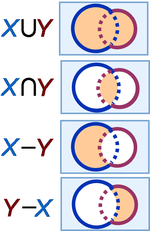Venn diagram
A Venn diagram is an arrangement of intersecting circles used to visually represent logical concepts and propositions.
Examples
Suppose X and Y are sets, for example, collections of some description. Various operations allow us to build new sets from them, and these definitions are illustrated using the three Venn diagrams in the figure.[1]
Union
The union of X and Y, written X∪Y, contains all the elements in X and all those in Y.
Intersection
The intersection of X and Y, written X∩Y, contains all the elements that are common to both X and Y.
Set difference
The difference X minus Y, written X−Y or X\Y, contains all those elements in X that are not also in Y.
Complement and universal set
The universal set (if it exists), usually denoted U, is a set of which everything under discussion is a member. In pure set theory, normally sets are the only objects considered. In that case, U would be the set of all sets. However, one may also consider sets that are collections of numbers, or colors, or books, for example; see Set (mathematics).
In the presence of a universal set we can define X′, the complement of X, to be U−X. X′ it contains everything in the universe apart from the elements of X.
History
The use of Venn diagrams was introduced by John Venn (1834-1923).[2] A brief biography is found in Hurley.[3]
References
- ↑ Alan Garnham, Jane Oakhill (1994). “§6.2.3b: Venn diagrams”, Thinking and reasoning. Wiley-Blackwell, pp. 105 ff. ISBN 0631170030.
- ↑ John Venn (1883). "On the employment of geometrical diagrams for the sensible representation of logical propositions". Proceedings of the Cambridge Philosophical Society: Mathematical and physical sciences 4: pp. 47 ff. and also John Venn (1881). “Chapter V: Diagrammatic representation”, Symbolic logic. Macmillan, pp. 100 ff.
- ↑ Patrick J. Hurley (2007). “Eminent logicians: John Venn”, A concise introduction to logic, 10th ed. Cengage learning. ISBN 0495503835.
Note: CZ:List-defined references methodology is used for references here.
